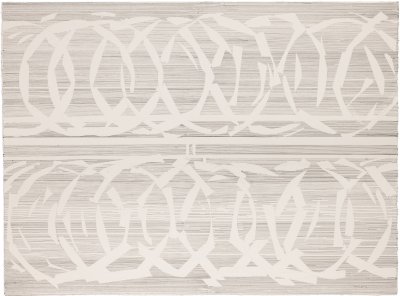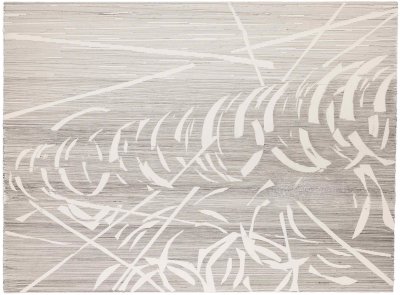Giovanni Campus. Tempo in processo. Rapporti, misure, connessioni
Drawings 2021-2023. Curated by Emma Zanella
 17 December 2023–07 April 2024
17 December 2023–07 April 2024
The Exhibition
The exhibition Tempo in processo. Rapporti, misure, connessioni highlights Giovanni Campus' latest challenging project, which began in late 2020.
The practice of drawing has always accompanied Campus' theoretical, artistic and even everyday research, from his first works in the 1950s to the present day.
Drawing, in fact, is for the artist a poetic experiential path that is more often than not autonomous, capable of bringing design to the threshold of the limit, in a markedly speculative dimension. Drawing is first and foremost a place of ascertainment and alternative questioning, free from more complex, spatial and material purposes.
In this latest cycle in particular, the Indian ink drawing, by its very nature slow and meditative, is a reflection on the global sense of the work in its temporality and consequentiality.
In each image, in each sheet there is in fact a before and an after that connect with the artist's research phases from the 1960s to his most recent works. Campus puts into practice an operation of traversing his own history, the fundamental passages, the most complex and even the most intimate works in order to lucidly investigate the temporal dimension of making and thinking art. This focus on Giovanni Campus was born on the occasion of the recent and important donation of a fund of ten works chosen by the artist for MA*GA's permanent collection.
The Artist
Giovanni Campus was born in Olbia in 1929. He left Sardinia in 1948. Classical studies in Genoa, Liceo G. Leopardi (Professor Dal Monte). He turned to painting, as a self-taught artist, in the early 1950s, experimenting with traditional techniques and new materials.
In 1960 he took part in the '26 Contemporary Artists', Galleria Incontri d'Arte, Rome, directed by Giuseppe Appella, and in the national exhibitions 'Premio Albano Laziale' and 'Premio Loffredo', Latina. In 1962 he took part in the 'III Mostra Internazionale', Palazzo Odescalchi, Rome. In 1966, he began his relationship with Galleria Giraldi in Livorno with a personal exhibition.
In 1966, 1972 and 1977 he was awarded the national painting prizes 'Città di Follonica', 'Città di Arcola' and 'Città di Carate Brianza', and in 2011, ex aequo, the 'La Spezia, Settembre d'Arte'. In the years 1968-1974, he took part in the avant-garde art exhibitions promoted by Numero and Technè in Florence, Sincron in Brescia and Galleria Giraldi in Livorno, and in operational meetings and interventions on the environment in Anfo and Novara, 1968, Pejo and Mentana, 1969, Galerija Doma Uluha, Zagreb, and Galerie't Venster, Rotterdam, 1970, Novi Sad and Belgrade, 1973.
Frequentations with critics Giuseppe Appella, Giulio Carlo Argan, Umbro Apollonio, Germano Beringheli, Luciano Inga Pin, Lara Vinca Masini, Aldo Passoni, Toni Toniato.
In 1968, he left his job to devote himself entirely to painting and moved first to the artists' quarter in Sesto San Giovanni and later to his studio in Via Solferino in Brera, Milan.
Practice, reflections and experiences specific to the period and place lead the figural language to a formal, aniconic, sequential, serial synthesis. Use of methacrylate, acrylic, metal. The silkscreen technique, practised directly by the artist, becomes the main expressive medium.
Working stays and exhibitions in the late sixties-eighties in Paris, "Salon Grands et jeunes d'aujourd'hui", 1972 and 1974, "Réalités Nouvelles" 1973 and 1974, "Comparaison", 1974; Galerie de l'Université, 1978, and Galerie Grare, 1986.
In the 1980s and 1990s in New York: College Scuola d'Italia, 1988, Scuola di New York, 1993, Hands Gallery, 1996 and 1998.
Invitations to present his work include the Reading Group Seminar Form and Matter in the Written and Visual Text of the Academy at Columbia University in New York in 1994, with Lavinia Lorch and, as respondents, Luciano Caramel, Salvatore Naitza, Charles Mercier and lngrid Rossellini.
Paths, interventions, installations, urban and natural, conducted alone or participated in, are to be understood as the implementation, in the context of verification, of the 'ideas' that drive the work in the studio. An epistemological work in the aesthetic. A place of phenomenal spatial temporal verification of the reasons for form. An operation aimed at probing relationships, relationalities and connections between the design measures of the vision, the naturalness of the place and the results of the intervention. In 1977 in the Piazzetta of the Palazzo Reale in Milan, with the collaboration of Arte Struktura, as well as artists and students from the Brera Academy of Fine Arts, he realised a 'continuous installation' with an environmental dimension: a series of paths of stretches of metal springs, suspended in tension, involving the urban spatiality. This was followed, with the collaboration for the technical part of architect Achille Castiglioni, by the 'inter-relational sign environments', sound and light with a temporal cadence (indoors) at the Galleria d'Arte Moderna in Bologna, 1978, and at the Museo Civico In Progress, Livorno, 1979.
Consequential determinations on the coast of Gallura in 1983. "Paths-interventions" obtained with considerable extensions of stretches of rope, suspended in a linear projection over the chosen natural area or delimiting rocks and portions of rock.
In 2004, on the Catena Limbara Sud mountains, with the students of the Orsoline high school and in the Garibaldi district in Milan, he realised, following specific 'conversations', a series of interventions-recognitions on 'comparative measures' (natural and urban). From this processuality conducted in parallel between representational projection and structural expressiveness, i.e. between idea and thing, came those series of works and groups of works, of different paintings and materials, in articulated full-empty spaces. First, in solo exhibitions, irregular concrete surfaces (Palazzo dei Diamanti, Ferrara, 1987-1988), followed by works with acrylic on canvas and shaped wood and iron extensions, and in recent times with directional iron planks, tangent and crossing works and physical spaces: CAMeC, La Spezia, 2012; Museo Civico Granai Villa Mimbelli, Livorno, 2015; Museo della Permanente, Milan, 2015; MAC, Museo Arte Contemporanea, Lissone 2017; MA*GA, Gallarate, 2019; BUILDING, Milan, 2019.



